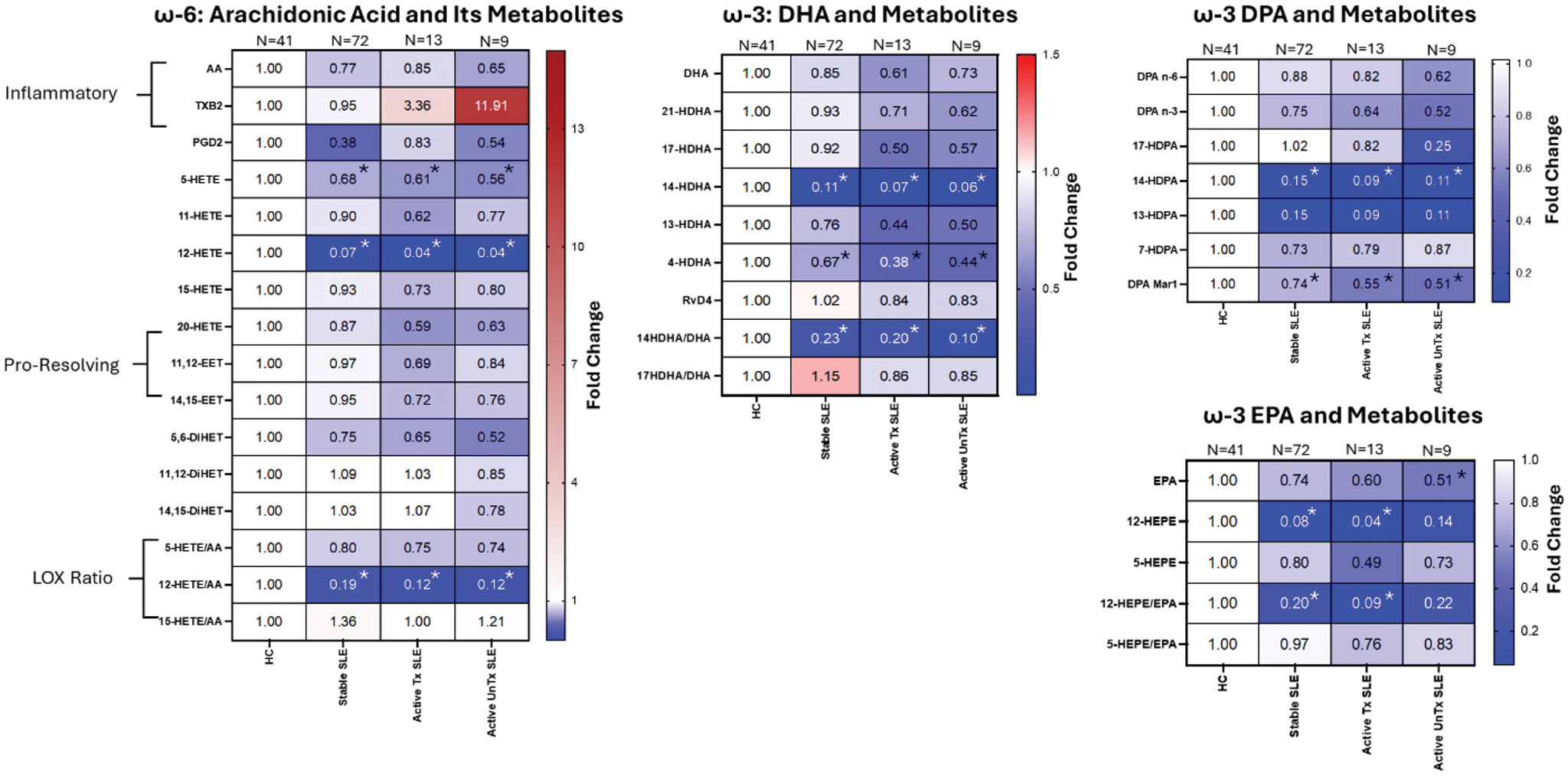

Background: Polyunsaturated fatty acids (PUFAs) derived from phospholipids can be metabolized to form eicosanoids, docosanoids, and specialized pro-resolving mediators (SPMs), play crucial roles in various inflammatory and immune responses. Although dysfunction in PUFAs metabolism has been reported sporadically in systemic lupus erythematosus (SLE), no comprehensive profiling of these metabolites in SLE has been conducted to date.
Objectives: This study aimed to compare the expression profiles of eicosanoid, docosanoids, and SPMs lipidome in patients with SLE with aged matched healthy controls (HCs) to elucidate their clinical significance in SLE.
Methods: The relative levels of eicosanoids, docosanoids, SPMs lipidome were analyzed using a targeted liquid chromatography-mass spectrometry (LC-MS) in plasma samples from 94 patients with SLE and 41 age- and sex-matched HCs. Active patient was defined as a SLE Disease Activity Index (SLEDAI) score ≥6 at the time of sampling.
Results: Plasma thromboxane B2 (TXB2) levels were significantly higher in active SLE compared to inactive SLE and HCs, while no significant difference was observed between HCs and inactive SLE (Figure 1). Several metabolites, including 5-HETE, 12-HETE, 14-HDHA, 4-HDHA, 14-HDPA, and DPA-derived maresin 1, were significantly lower in patients with SLE when compared to HCs. These metabolites showed a decreasing trend across the four groups: HCs, inactive SLE, active treated SLE, and active untreated SLE. The activity ratios of key enzymes, such as 12-lipoxygenase (12-LOX) and 15-lipoxygenase (15-LOX), represented by 12-HETE/AA, 12-HEPE/EPA, and 14-HDHA/DHA, were significantly reduced in SLE patients compared to HCs. Additionally, specific metabolites, including 12-HETE, 15-HETE, and 20-HETE, as well as the 15-HETE/AA ratio (indicative of 15-LOX activity), were significantly correlated with anti-dsDNA antibody levels.
Conclusion: This study demonstrated a systemic reduction in ω-3 PUFAs in patients with SLE, alongside a significant elevation of TXB2 levels in active SLE. Additionally, these findings showed a significant reduction of SPMs like DPA-maresin1 in relations controlled-, active-treated and active untreated SLE when compared to HC. Using functional lipidomics, this study identified dysfunction in 12-LOX and 15-LOX enzyme activities contributing to the pathogenesis of SLE.
REFERENCES: [1] Ahluwalia K, Ebright B, Chow K, Dave P, Mead A, Poblete R, Louie SG, Asante I. Lipidomics in understanding pathophysiology and pharmacologic effects in inflammatory diseases: consideration for drug development. Metabolites. 2022;12(4):333.
[2] Kobayashi A, Ito A, Shirakawa I, Tamura A, Tomono S, Shindou H, Hedde PN, Tanaka M, et al. Dietary supplementation with eicosapentaenoic acid inhibits plasma cell differentiation and attenuate lupus autoimmunity. Front Immunol. 2021;12:650856.
Heatmaps showing the relative concentrations of eicosanoids, docosanoids, SPMs lipidomes in patients with SLE and healthy controls. DHA, docosahexaenoic acid; DPA, docosapentaenoic acid; EPA, eicosapentaenoic acid.

Acknowledgements: NIL.
Disclosure of Interests: None declared.
© The Authors 2025. This abstract is an open access article published in Annals of Rheumatic Diseases under the CC BY-NC-ND license (